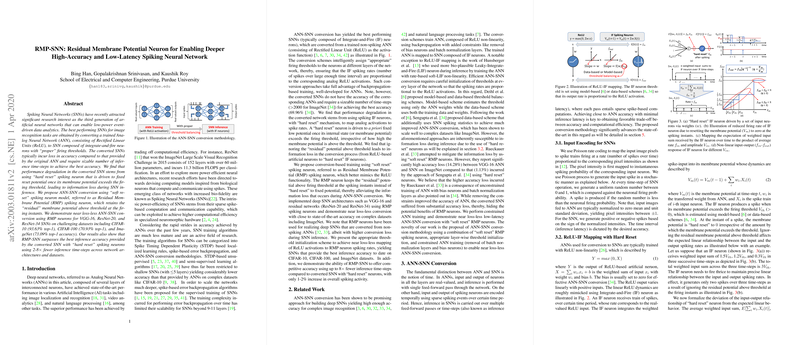RMP-SNN: Enhancing Spiking Neural Networks with Residual Membrane Potential Neurons
The paper "RMP-SNN: Residual Membrane Potential Neuron for Enabling Deeper High-Accuracy and Low-Latency Spiking Neural Network" by Bing Han, Gopalakrishnan Srinivasan, and Kaushik Roy offers a significant methodological advancement in the domain of Spiking Neural Networks (SNNs). With the increasing demand for energy-efficient computational models, SNNs have garnered attention due to their biological plausibility and low-power operation, especially beneficial for neuromorphic hardware. This paper introduces the Residual Membrane Potential (RMP) neuron model, which aims to substantially mitigate accuracy loss typically associated with the conversion from Analog Neural Networks (ANNs) to SNNs.
Problem Addressed and Methodological Innovation
The primary challenge addressed in this work is the information loss occurring during the conversion process of ANNs, composed of Rectified Linear Unit (ReLU) activations, to traditional Integrate-and-Fire (IF) neuron-based SNNs. This conversion often results in decreased inference accuracy and increased latency due to inefficiencies in the traditional "hard reset" mechanism used in IF neurons. The authors identify that such a reset mechanism leads to unnecessary information loss, affecting the performance of the spiking network.
The innovative aspect of this paper lies in proposing a "soft reset" mechanism for spiking neurons, referred to as Residual Membrane Potential (RMP) neurons. Unlike "hard reset," where excess potential above the threshold is irrecoverably lost, RMP neurons retain this residual potential, thereby preserving information through spiking events. This methodological shift enables the near loss-less conversion of ANNs into SNNs, maintaining high accuracy with significantly reduced latency.
Empirical Performance and Results
The paper provides extensive empirical validation of the proposed RMP-SNNs on benchmark datasets, namely CIFAR-10, CIFAR-100, and ImageNet, utilizing prominent architectures like VGG-16 and various ResNet configurations. The results demonstrate that RMP-SNNs achieve comparable or superior accuracy compared to their ANN counterparts, with minimal accuracy loss post conversion. For instance, VGG-16 architecture achieved accuracy levels of 93.63% on CIFAR-10 and 73.09% on ImageNet, effectively narrowing down the conversion accuracy gap to below 0.5% in most cases.
Moreover, the conversion to RMP-SNNs generally required fewer inference time-steps compared to traditional SNNs, with reductions ranging from 2 to 8 times across various networks and datasets. This reduction is achieved with negligible increases in overall spiking activity (less than 2%), highlighting the efficiency of the RMP mechanism.
Implications and Future Work
The introduction of RMP neurons offers significant implications for the practical deployment of SNNs in real-world applications, particularly where computational efficiency and energy consumption are paramount. This advancement opens pathways for the application of SNNs in more complex domains previously limited by accuracy and latency issues.
From a theoretical standpoint, the paper's contribution adds a layer of understanding regarding neuron dynamics, particularly in mirroring the analog computation potential in discrete spiking events. This could inspire further explorations into more complex neuron models that can mimic other nonlinear activations present in ANNs.
Future developments could investigate the integration of RMP neurons in hardware design, optimizing them for neuromorphic chips that leverage the advantages of low-power and high-efficiency computing. Moreover, applying RMP-based conversions to broader neural network tasks, such as sequential data processing or more intricate generative tasks, could broaden the scope and potential of SNNs further.
In conclusion, the proposed RMP-SNN framework presents a robust bridge between ANNs and SNNs, showcasing the potential for SNNs to effectively scale and perform in parity with, or even exceed, traditional neural network models in various application domains.
